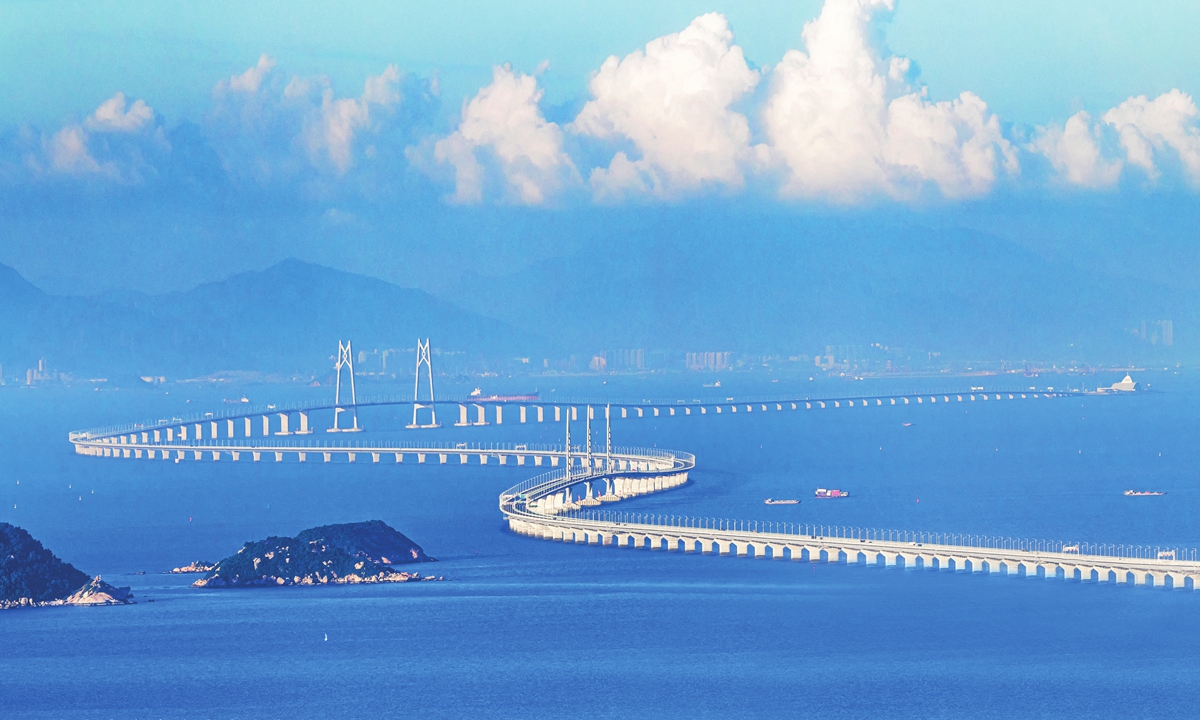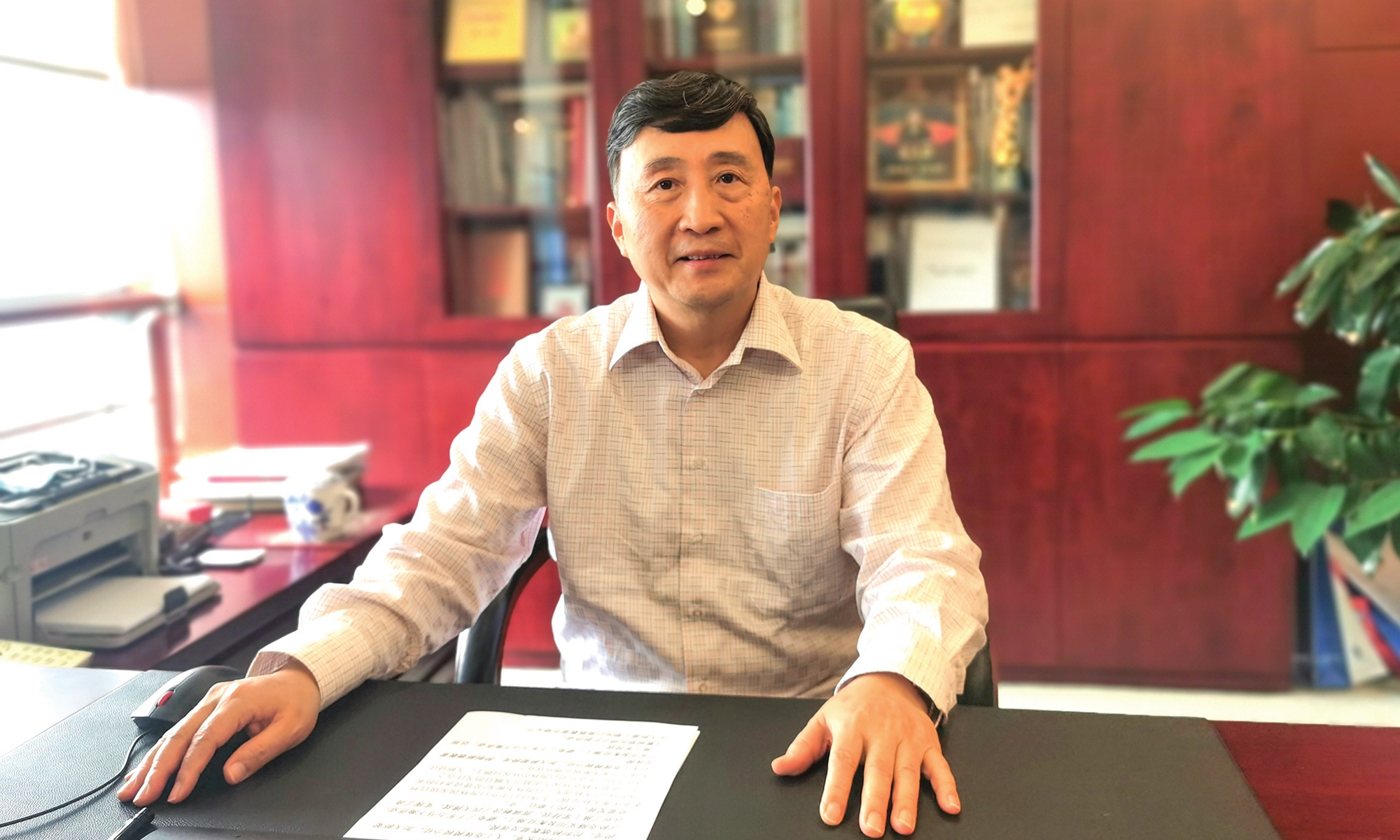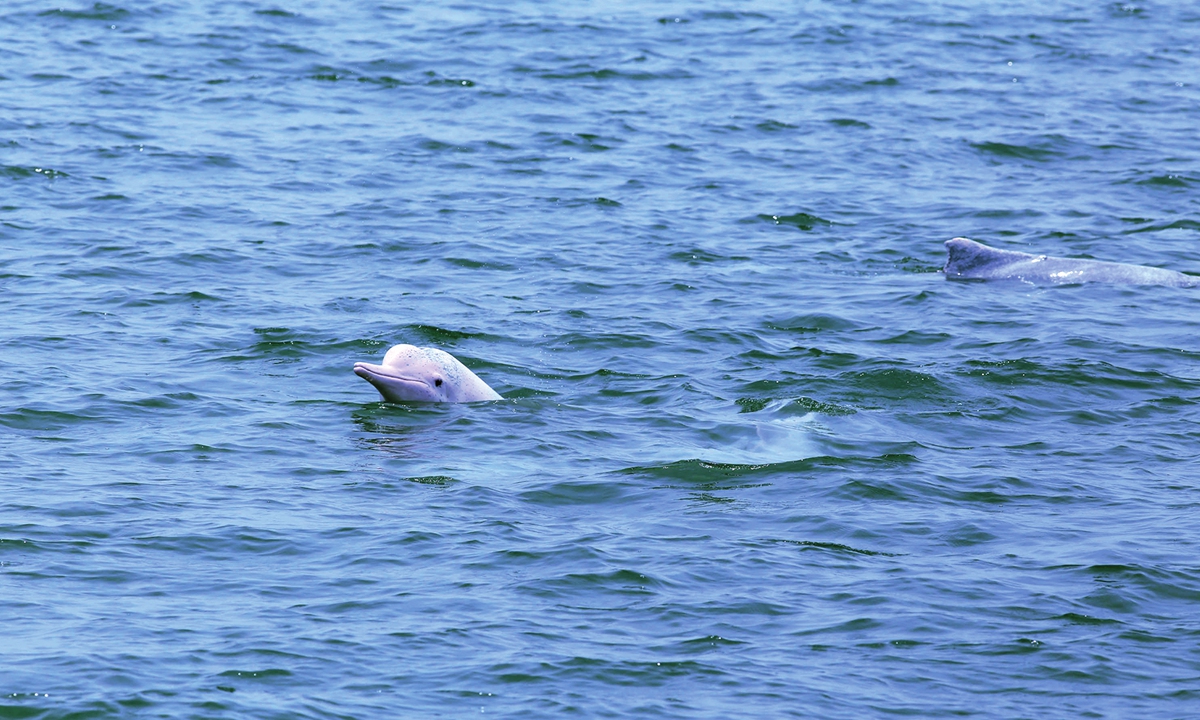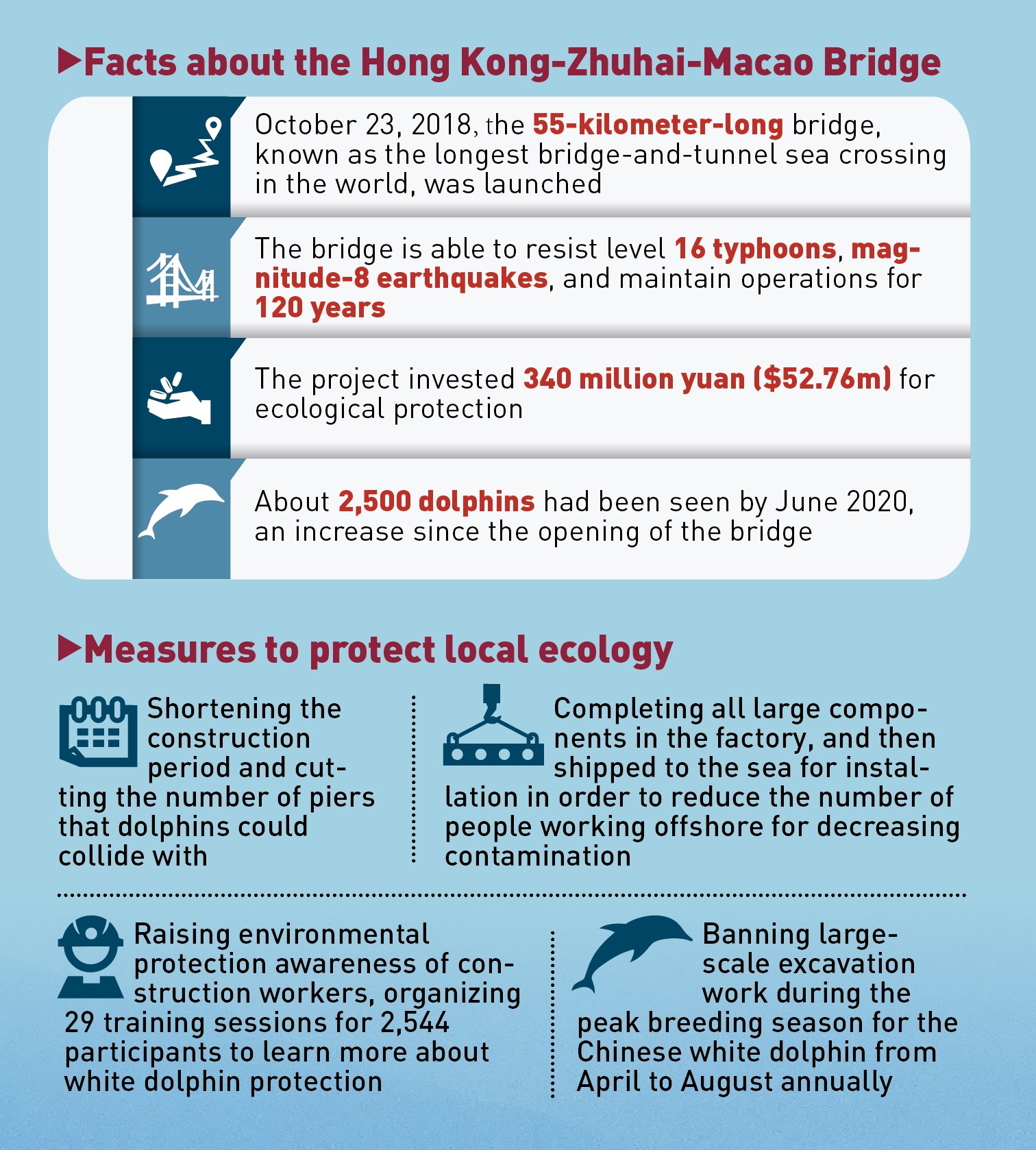
Hong Kong-Zhuhai-Macao Bridge Photo: VCG
Launched on October 23, 2018, the 55-kilometer-long Hong Kong-Zhuhai-Macao Bridge, which is known as the longest bridge-and-tunnel sea crossing in the world, links China's Hong Kong Special Administrative Region (HKSAR), Zhuhai of South China's Guangdong Province and Macao SAR, and cuts the travel time between the three places to one-sixth of the original travel time.
The Y-shaped gigantic project consists of a series of bridges, artificial islands and a tunnel facilitates travel that used to be separated by channels.
The bridge is able to resist level 16 typhoons, magnitude-8 earthquakes, and maintain operations for 120 years. As one of the world's largest cross-sea transportation projects, the bridge is known as the "project of the century" and an example of the highest standards of engineering technology in China's transportation history.
China's knowledge in minimizing environmental harm when building the bridge, which runs across waters that is the primary habitat of Chinese white dolphins - also known as the Indo-Pacific humpback dolphin - has served as a science-oriented inspiration for averting risk to marine life.
Meng Fanchao, chief designer of the bridge, disclosed the preservation efforts that had led the bridge to become an environmental protection model, in a recent exclusive interview with the Global Times. The design team has made efforts in reducing the ecological impact of the bridge, under the guidance of national-level biodiversity programs.
A tricky balanceTo preserve the Chinese white dolphin's natural habitat, builders of the bridge that started in 2009 allocated 340 million yuan ($52.76 million) to the project toward the protection efforts.
The rare Chinese white dolphin, nicknamed the "giant panda of the sea," is under first class state protection and primarily lives in the Pearl River Estuary in southeastern China.
To shun the Chinese white dolphin reserve area, the overall location of the bridge needs to be moved northward or southward, which will greatly increase not only its operating mileage, but also improve the construction scale and cost. Also, the concept of the "one-hour living circle" that enables individuals in the Greater Bay Area to move from one location to another within about an hour would not have been achieved.
However, ecological protection is not only a red line, but also a rule that must be adhered to, Meng said, adding that the construction team carefully studied the living habits of the dolphins, constantly brainstorming way to minimize negative impacts on them.

Meng Fanchao Photo: Courtesy of Meng Fanchao
What surprised the public most is that more white dolphins seem to have appeared since the bridge was built. The latest official data suggests that about 2,500 dolphins had been spotted by June 2020, increased from 2,367 in 2017, media reported.
This is largely thanks to innovative and optimized construction plans, close research and monitoring of dolphins and the joint efforts of the governments of Hong Kong, Macao and Zhuhai.
Meng said the team constantly revised design schemes to minimize disturbance to the dolphins, such as shortening the construction period and cutting the number of piers that dolphins could collide with.
The design team asked all large components to be completed in the factory before shipping to the sea for installation in order to reduce the number of people working offshore for decreased the marine debris contaminating the marine environment, said Meng.
The manufacture of steel towers and bridge piers can be completed in the factory with standardized assembly line operation, which greatly reduces construction periods and improves efficiency, Meng said.

A wild Chinese white dolphin Photo: cnsphoto
"Manufacturing in a factory and assembling offshore helped reduce the impact of harsh weather conditions on construction and ecological damage. It is an innovative attempt in the history of international, large-scale bridge construction," said Meng.
In comparison, a more traditional approach to offshore operations has low efficiency, high safety risks and larger quantities of pollution and emissions. One can imagine the great deal of ecological damage that would be meted against the environment if personnel's excrement and combined refuse were all dumped into the ocean, according to Meng.
The construction team was also not allowed to conduct large-scale excavation work that could cause rubbish to float on the surface of the water during the peak breeding season of the Chinese white dolphin from April to August.
Strong awareness and huge investmentWorkers' vigilance to avoid dolphins was important during the construction, and was helped by training and education.
Managerial personnel kept monitoring the nearby environment and the dolphins via intelligent equipment including the bridge video surveillance system, the underwater tunnel's environmental monitoring as well as specially established research and observation stations on the man-made islands, Yu Lie, deputy director of the bridge management bureau once told the media.
In 2011, for example, while construction was underway on an artificial island, observers spotted two Chinese white dolphins a few hundred meters off the island. According to the principle of "stop working and await if dolphins turning up within 500 meters," the construction work was stopped until the two naughty dolphins left the area after playing for more than four hours.

Hong Kong-Zhuhai-Macao Bridge Photo: VCG
Media reports said that during the construction period, researchers tracked the species more than 300 times, took more than 300,000 photos, identified more than 1,000 Chinese white dolphins, and organized 29 training sessions for a total of 2,544 participants to learn more about protection efforts.
Since the construction of the main project of the bridge, 80 million yuan has been directly invested into ecological compensation for Chinese white dolphins, 41.37 million yuan for monitoring expenses related to construction, 9 million yuan for environmental protection consultants, 188 million yuan for ecological loss compensation of fishery resources, 10 million yuan for environmental protection research, and about 8 million yuan for other incidental costs. The total amount that's gone into conservation efforts stands at about 340 million yuan, Shanghai-based the Paper reported.
The whole project team has achieved "zero pollution" of the marine environment and "zero injury and death" of the dolphins, according to Meng.
"The bridge has set the standard for quality and environmental protection in the field of cross-sea engineering. This is also due to China's strict assessment and inspection of environmental protection for large-scale projects in recent years, and the continuously improved red line of ecological and environmental protection," said Meng. "It is important for Chinese bridge engineering projects to launch an innovative plan to balance potential environmental and economic benefits in the planning stages, and hasten the supervision mechanism in the following procedures."
How to balance efficiency and economic benefits with environmental protection in major infrastructure projects has been a test for China's expertise, said Meng. Thebridge has become a project with complex technology, highest environmental protection requirements, and strictest construction standards in the history of Chinese bridges.
The preservation efforts never stopped even after the construction was completed. The continued monitoring and surveying of the dolphins in Lingding Bay and in their other habitats is still going on, Meng said. And governments from three regions have formed a conservation alliance for the dolphins, gathering NGOs and professional researchers in the routine rescue, information sharing, and scientific research, Meng noted.
"We are now confident to say that the bridge has taken the lead in environmental protection among world-class super-large bridges," said Meng.







